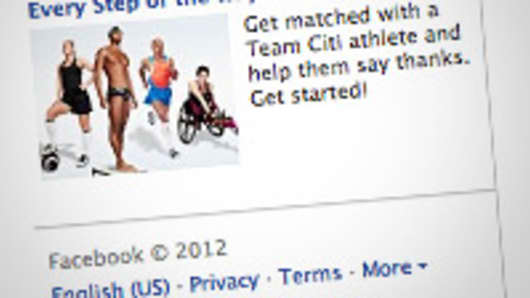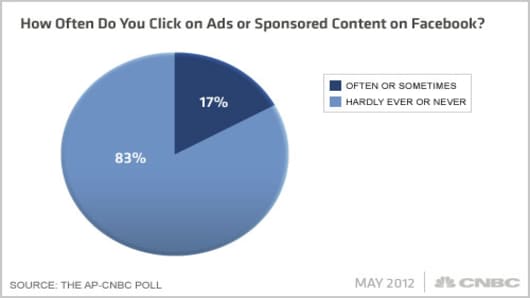For Facebook, advertising is a gold mine: it represents a wide majority of the company’s revenues. It can market targeted information to its nearly a billion users/consumers, who stay engaged on the platform for hours each month.
A veritable gold mine — but for how long?
A poll by the Associated Press and CNBC found that the majority of Facebook users have never clicked on an ad, a finding that calls into question the effectiveness of the site’s ad real estate.
Of the 1,004 respondents, 57 percent said they had never clicked on ads or sponsored content when using Facebook. Widening the group to include those who “hardly ever” clicked on advertising content would include 83 percent of respondents.
COO Sheryl Sandberg has crafted a careful advertising strategy for the company since her arrival in early 2008, after which Facebook’s revenues — largely from ads — began skyrocketing as the network sprawled. In Facebook’s S-1 filing, it hails “reach, relevance, social context, and engagement” as the hallmarks for advertisers looking to divvy up some $588 billion in global ad spend.
For advertisers, Facebook users are not only engaged on the network for a long time, but the S-1 also claims that those users are “likely to have purchase intent.”
For complete poll results, click here.
Advertisers should look beyond the social network, however, to harness that purchasing power, the AP-CNBC poll found. Some 54 percent of respondents felt not very safe, or not safe at all, when asked about making purchases of clothing and goods on the network.
Facebook expects the advent of its Timeline product for advertisers will change that; by integrating ads into news feeds, “sponsored stories” will be associated with the user’s own curated content. The hope? That capitalizing on a product connection from a Facebook friend will create brand recognition and, more importantly, trust.
Finding so-called “social context” for these ads will take time. Sandberg told investors during the IPO roadshow that only 13 percent of the site’s advertising content currently has that context, according to one of the meeting’s attendees.
Regardless of Facebook’s intent to integrate ads, the sheer number could be enough to disillusion a user who is already not clicking on Facebook ads. The problem is clear: as a public company, Facebook will be hard-pressed to show steep profit growth for a large stable of value investors, while not alienating ad-averse users.
Facebook is expected to price after the bell on Thursday, May 17 and will begin trading on the Nasdaq on Friday, May 18 under the symbol FB.
-By CNBC’s Kayla Tausche
@kaylatausche
-Associated Press contributed to this post.




